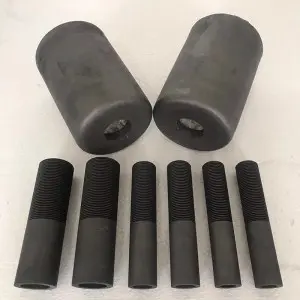Graphite mold technology plays an essential role in precision manufacturing and metal casting. As industries demand higher accuracy, longer mold life, and stable production quality, the importance of reliable graphite mold solutions continues to grow. For commercial foundries, casting facilities, and OEM manufacturers, graphite molds offer superior performance, cost efficiency, and thermal stability compared to traditional mold materials.
Understanding the Role of Graphite Mold in Modern Manufacturing
Graphite molds are widely used in metal casting, glass forming, continuous casting, and semiconductor production. Their ability to withstand extreme temperature, maintain dimensional accuracy, and provide smooth surface finish has made them an indispensable tool across multiple industrial sectors.
Unlike steel or ceramic molds, graphite molds provide exceptional thermal and structural properties. They support high-temperature casting and processing of metals such as gold, silver, copper, aluminum, zinc, and stainless alloys. In advanced manufacturing environments, they also play a major role in precision forming and semiconductor component production.
Graphite molds can be customized for mass production, prototype testing, and specialty processing in industries where accuracy and repeatability are critical.
Key Applications of Graphite Mold in Industrial Production
Graphite molds are utilized in a wide range of industries. Their flexibility, thermal resistance, and excellent mechanical properties enable stable casting performance under extreme conditions.
Industries that commonly use graphite molds include:
• Precious metal manufacturing and casting
• Automotive and aerospace component production
• Semiconductor and electronic industries
• Industrial furnace processing
• Metalworking, alloy forming, and continuous casting
• Glass processing and molding
From jewelry making to high-tech semiconductor applications, graphite molds provide reliability, precision, and durability under high-temperature environments.
Advantages of Using Graphite Mold in Manufacturing
Industrial companies rely on graphite molds for their ability to deliver consistent results, reduce operational costs, and improve the quality of finished products. The stability of graphite material provides better processing outcomes for both mass and customized production.
Key advantages include:
• Excellent thermal conductivity and heat resistance
• Low thermal expansion for dimensional stability
• Smooth surface finish requiring minimal post-processing
• Long mold lifespan and reduced tool wear
• Compatibility with precious and non-ferrous metal casting
• Strong oxidation resistance under controlled processing conditions
These benefits enable manufacturers to achieve higher yield rates and greater product consistency.
Technical Features and Properties of Graphite Mold
One of the most important features of graphite mold is its thermal stability under high temperature conditions. Graphite maintains structural strength even when exposed to extreme heat and thermal cycling.
Graphite molds provide:
• High density and mechanical strength
• Resistance to thermal shock and deformation
• Excellent lubricity and anti-stick behavior
• Stable chemical and oxidation resistance
• Strong tolerance to temperature fluctuation
These attributes are particularly important in automated foundry processes, precision die-casting, and continuous production lines.
Customization and Design Flexibility
Graphite molds are available in a variety of shapes, dimensions, and configurations. Manufacturers can design graphite molds for simple, complex, or multi-cavity casting applications.
Customization supports different casting requirements, including:
• Specific cavity dimensions and surface finishing
• Complex geometries and deep cavities
• Continuous casting channels and runners
• Custom metallurgical conditions
This flexibility enables manufacturers to optimize mold performance according to production specifications.
Cost Efficiency and Equipment Optimization
Graphite molds help reduce overall manufacturing cost and improve production efficiency. Since graphite mold material resists thermal fatigue and wear, it provides longer service life and reduces replacement frequency.
Manufacturers benefit from:
• Lower maintenance and tooling cost
• Shorter machining time and improved surface finishing
• Increased production efficiency
• More predictable performance during casting cycles
This results in greater operational stability and lower long-term processing cost.
Graphite Mold vs Traditional Mold Materials
Traditional mold materials such as steel or ceramic tend to deform, oxidize, or crack under extreme heat. Graphite molds outperform other mold materials in high-temperature production.
Comparison advantages include:
• Lower risk of cracking and thermal stress
• Better dimensional precision and stability
• Faster cooling and improved cycle time
• Less machining and finishing required
These improvements are particularly meaningful for mass production and precision casting applications.
Industrial Growth and Demand for Graphite Mold
The global industrial manufacturing sector continues to increase investments in high-performance mold technology. The demand is growing due to automation, energy efficiency, and high-precision production.
Industries using graphite molds benefit from:
• Improved product accuracy
• Better control over casting quality
• Increased production scale
• Technology compatibility with CNC machining
As more industries adopt advanced casting and thermal forming solutions, graphite mold continues to play a strategic role in the supply chain.
Choosing the Right Graphite Mold Manufacturer
Manufacturers and industrial buyers must evaluate mold specifications, thermal resistance, surface properties, and machining quality. Selecting the right mold supplier ensures stable performance and long-term production success.
Important considerations include:
• Mold density and purity
• Dimensional tolerance and precision machining
• Thermal and mechanical durability
• Application-specific design engineering
• Surface finish and oxidation resistance
Choosing a reliable graphite mold manufacturer results in better performance and long-term operational efficiency.
Conclusion
The graphite mold is a key solution in industrial manufacturing, metal casting, semiconductor processing, and precision forming. Its unique thermal and mechanical properties provide better production outcomes and cost control. For industrial buyers and manufacturers, graphite molds offer durability, thermal stability, and improved product quality.
Whether used in metal casting, semiconductor engineering, or precision die shaping, graphite molds remain an essential component in modern industrial production.
FAQ
1. What materials can be used with graphite mold?
Graphite molds are suitable for gold, silver, copper, aluminum, zinc, and other metals.
2. Why are graphite molds used in high-temperature applications?
Graphite provides excellent thermal resistance, mechanical stability, and oxidation resistance.
3. Are graphite molds suitable for mass production?
Yes. They support precision manufacturing, continuous casting, and industrial batch operations.
4. How long does a graphite mold last?
Service life varies by usage conditions, but graphite molds offer long operational durability compared to metal or ceramic molds.
Post time: Nov-27-2025
